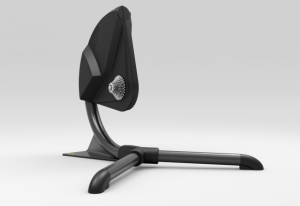In the expo area at the Hawaiian Ironman in Kona, Saris had its new H3 smart, direct drive trainer strapped atop a platform on rails. This construction is being marketed as the MP1 Nfinity Trainer Platform. I’ve heard it referred to as a motion platform and a rocker plate. Whatever you want to call it, it was one of the coolest things I experienced at the expo this year.

So what is this thing? It’s a platform atop which you attach your trainer, and it rocks. I don’t mean “rocks” in the “first and fourth finger-extended, head banging” sense, rather in the “sway to and fro” sense, and you should take that quite literally. The MP1 platform doesn’t just rock & roll from side-to-side, it also moves fore and aft. If you’ve ever had to dodge a wheel coming back toward you as the rider in front of you stood to get out of the saddle, you have a sense of what Saris is trying to emulate here, and even the small amount of time I spent on it in the expo was enough to convince me that they’re onto something. Stand out of the saddle when you’re on this and you can feel the bike shoot back a wee bit, just as it does on the road. Really put some power into the pedals, and the bike moves underneath you, a bit forward, a bit back, a bit sideways. The MP1 animates the bike – the bolt of lightning awakening Frankenstein’s monster – providing a stationary riding experience that finally reacts like a bike on the road. It’s alive!
It felt “real” enough that I found myself wanting to strap the trainers from the other manufacturers onto it just to (un)level the playing field in the feel contest. Pretty impressive for something that doesn’t look like much when it’s just sitting there.
Here is a GCN-produced video of the platform. Yes, this is a paid presentation, and is so-labeled in the video. Still, it’s a well-made video and I’m including it here because it’ll give you a sense of how it reacts to the rider’s inputs, and you can see what this thing looks like underneath, if you want to watch the entire video. (There are some other things in the video, but it’s mostly about the MP1.)
Speaking of other trainers, have you noticed that trainers have taken a next step? The Wahoo Kickr Climb injects ascending into the ride. What would happen if a Kickr was affixed to the back of the MP1, and a Kickr Climb to the front? Would you then get a 100 percent accurate road feel, excluding descents? Meaning, the road feel of the MP1 plus the capacity to ride uphill? In and out of the saddle? Does all of that smart trainer hardware fit onto an MP1?
What about these new units from Wahoo, Tacx, Stages, adjustable bikes with smart trainers built in? Could one place these bikes fit on the MP1? The Kickr Bike stands a chance, because it’s support profile is roughly analogous to the MP1’s profile (below).

But I haven’t tried to put the bike on the platform; I don’t know how the two would do with each other; I haven’t spoke to Wahoo or Saris about it. Is the bike too heavy for the trainer? A Kickr Bike weighs 93 pounds, a Kickr 47 pounds, so a Kickr and a bike is around 25 pounds lighter than the Kickr Bike alone. Seems like a trivial difference, considering the MP1 is “Tested to the combined weight (rider, bike and trainer) of 350 lb.” On paper, that should mean that the MP1 plus the Kickr Bike allows the rider plus his kit, shoes, paraphernalia to be no more than about 250 pounds. But my speculation is filled with asterisks!! Until I test this contemplated Pain Cave Construct (Kickr Bike + MP1 Nfinity) myself, or hear from Wahoo and Saris that it's a good idea, I can’t recommend this. File this as no more than a thought experiment.
That said, continuing this thought, other bikes, like the Tacx NEO Bike, that are supported by a wider footprint in the front, and would I fear not fit aboard the MP1. Circling back to the Kickr + Kickr Climb, that certainly seems to be a construct that would fit aboard the MP1. Again, though, I'd like to hear from both brands on this before I get too far over my skis. Or my handlebars.
The MP1 sells for $1,200, which is equal to the cost of a top quality trainer. If you spent this much on a trainer last year, and you have a like amount of cash trying to jump out of your pocket as stationary season approaches, I think this might take your pain cave up a notch. I don’t see why any trainer wouldn’t work on it, and this is Saris’s view as well. The MP1 is made in Wisconsin, where Saris is headquartered, and has a lifetime warrantee. You can read about it on Saris’s website.



